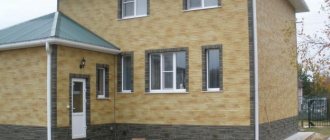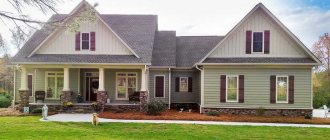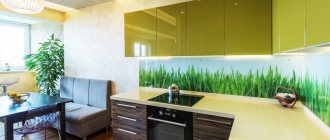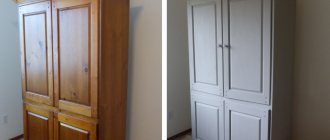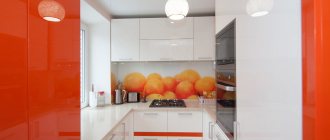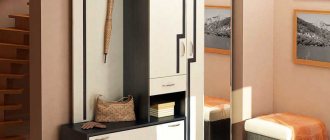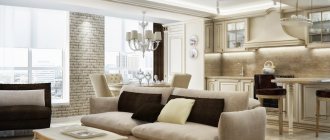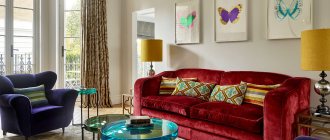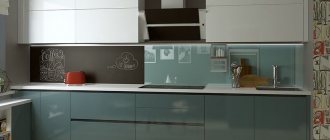Basic requirements for a kitchen façade
The kitchen is a place with frequent changes in temperature and humidity; drops of water, dirt and grease can fall on various surfaces. In addition, you often have to deal with hot dishes and brightly colored foods. All this creates special requirements for the material of the kitchen facade. Among the main ones we note:
- resistance to moisture , including direct contact with drops of water, as well as exposure to high humidity and steam;
- resistance to high temperatures , since surfaces near the stove and oven heat up quite well, and contact with hot dishes is possible;
- ease of care . Kitchen facades should be easy to clean from drops of grease and dirt, fingerprints, traces of dishes, food debris, etc.;
- resistance to mold and mildew . Ideally, the material itself should not rot, and also not allow microflora to multiply;
- resistance to impacts and scratches will allow the facade to retain its original appearance for a long time;
- resistance to natural dyes . Wine, coffee, various juices, and blood from meat are easily absorbed into porous materials and are difficult to remove later. Therefore, the facade material should not be porous;
- durability;
- aesthetics . The kitchen façade should not irritate or spoil your appetite. That's the minimum. Ideally, it should fit into the interior of the kitchen in style and color, and meet the tastes and preferences of the household.
There are many requirements, but there are also a lot of materials that meet them. Facades made of wood, MDF and chipboard are actively used; metal options are considered rarer and more exclusive.
You can buy and order kitchen facades in Moscow from the manufacturer on the website. During production, Italian and German equipment is used, modern technologies are used. Kitchen fronts are made of wood, MDF and plastic. The range of colors and textures is crazy.
Types and shape of facades
Today the following types of facades are distinguished:
- Blinds - are a canvas in the form of blinds or grilles. Provide the best air exchange and extend the service life of the material.
- Frame, paneled - include panels made of wood, chipboard, MDF, plywood and other materials.
- Solid - the most expensive type of facade, which is made from natural solid wood. Usually impregnated with adhesive components to achieve greatest strength.
In accordance with the shapes of the finished kitchen set, today there are the following configurations of facades:
- Angular. Semicircular facades, which are used for L-shaped sets.
- Direct. Standard classic version. It is a smooth canvas without bends.
- Radial. Unique designs that can have a convex or concave shape. They are used mainly for non-standard creative design of kitchen interiors.
Wooden facade
Wood is classic, tradition and elegance. Such facades fit perfectly into the classic and Scandinavian style, and look good in country and Provence. Wood gives the room a special warmth and comfort.
Advantages of wooden facades:
- environmental friendliness and the presence of a pleasant natural woody aroma;
- presentable appearance, solidity and elegance;
- durability;
- maintainability. If scratches, abrasions and other defects appear on the wood over time, they can be easily eliminated using special equipment. All that remains is to apply a layer of varnish or paint - and the facade will be as good as new;
- the ability to quickly transform your appearance. Using varnish, paint or stain, wood can be given any shade and look you want. There are aging techniques, and an inexpensive pine facade can be transformed so that it is indistinguishable from its mahogany counterpart;
- solid wood is a dense, homogeneous material, therefore the fasteners in it hold well.
Minuses:
- high price. A facade made of natural wood is not a cheap pleasure, so some manufacturers make the technology a little cheaper. The frame of the sash is made of solid wood, and a panel made of another material is inserted inside, incl. glass or MDF. By the way, veneered MDF is difficult to distinguish from wood in appearance. It turns out to save money, preserve the woody aroma, and not suffer in terms of aesthetics;
- if the protective coating is damaged, moisture can get inside the wood, causing swelling of the sashes, subsequent difficulties in opening them, creaks and the appearance of mold. So the protective coating must be protected and updated as necessary;
- humidity, which varies widely in the kitchen, can affect the size of the facade. Fluctuations within 2-3 mm are possible;
- wood suffers from rotting and darkening, but there are species that are more resistant to these phenomena than others. These are, for example, larch, oak and beech;
- Detergents must be chosen carefully. The use of abrasives is not allowed, and some products may contain substances hazardous to wood.
There are also those who blame the tree for lack of diversity. If we take into account the unique shade of each species, the wide possibilities of finishing (varnishing, staining, patination, etc.) and decoration (creating carvings and panels), it becomes obvious that wooden facades are quite diverse.
Different types of wood are used to make kitchen facades
- pine is the most budget-friendly species, costs a little more than wood panels, and is highly soft, so even pets can scratch the material. Restoration will have to be carried out too often, and if you consider that every damage is a risk of moisture getting inside the material, then it is better to look towards other species, and use pine as much as possible for making the frame;
- Ash is much denser than pine, but also a couple of times more expensive. The wood has a light, slightly yellowish tint, looks great in a Scandinavian interior, but if desired, it can be given a different shade;
- oak is durable, expensive wood of rich color, it is a true classic, although some may think that such a facade looks gloomy;
- beech is similar in color to oak, costs a little less, and performs well in use;
- Larch has an important advantage - resistance to moisture. This wood was used in the construction of the foundations of Venetian houses and for the construction of ships, so it will withstand steam in the kitchen;
- cedar, cherry, mahogany, and exotic wood are less common materials. Such facades are expensive, but they also look exclusive.
Wooden facades are heavy, so experts advise combining them with solid wood frames - glued slabs may simply not withstand the load.
Kitchen facade made of MDF
Most facades are made from MDF. This is a relatively inexpensive material that has acceptable durability and good performance. MDF is made from fine wood chips, which are pressed under high temperature and pressure. Urea resins are used as a binder, therefore the formaldehyde emission of the finished board is low, at the level of natural wood. If you compare the cut of an MDF board and a chipboard, you can see that MDF has a much higher density, which explains its performance characteristics. In itself, such a slab is unprepossessing, but thanks to numerous finishing methods this deficiency can be compensated for.
Advantages of kitchen facades made of MDF:
- moisture resistance is higher than that of wood and chipboard;
- high strength, which allows the plate to easily cope with shocks and other mechanical influences;
- the durability of MDF is lower than that of wood, but much higher than that of chipboard;
- resistance to temperature influences and changes in humidity - what you need for the kitchen;
- affordable cost, especially when compared with its wood counterpart;
- ease of processing, which allows you to create facades of various shapes;
- environmental friendliness;
- variety of finishes. MDF boards can be painted, veneered, covered with film or plastic.
The disadvantages include lower durability compared to wood, but the price of MDF is also much lower.
Some of the performance qualities of the facade strongly depend on what material it is finished with, so this point needs to be considered in detail.
Painted MDF facade
The manufacturing technology involves treating the facade with a primer, after which several layers of enamel are applied to it, then a layer of varnish is applied to the dried coating, and the final stage is polishing.
Advantages:
- wide selection of shades and textures. The color can be almost any, and the surface itself can be glossy, matte, pearlescent;
- the ability to produce a façade of any shape;
- surface resistance to fading, mechanical stress and temperature fluctuations;
- Easy to clean - just wipe the surface with soapy water. It is better not to use abrasive products to avoid leaving scratches.
Flaws:
- high cost, only veneered MDF is more expensive;
- Fingerprints and other dirt are clearly visible on the glossy surface;
- with a strong impact, chips may appear, but small scratches can be easily restored;
- need to wash only with soapy water.
Laminated MDF
A polyvinyl chloride film can be applied to MDF under pressure. It doesn’t look very good, but it’s extremely affordable.
Advantages:
- low price;
- a variety of films, so you can imitate any type of wood, stone or leather. True, it is difficult to say that such an imitation will look natural;
- the film can be glued to facades of any shape;
- The film is not afraid of moisture, is easy to clean, and is quite resistant to abrasion.
Minuses:
- the film is afraid of high temperatures, especially their prolonged exposure, so it can begin to deform in places near the oven and stove;
- sensitivity to direct sunlight;
- low durability;
- Be careful when choosing detergents, as some aggressive substances can corrode the film or cause color changes.
Veneered MDF
Veneer is a thin section (up to 3 mm) of solid wood, which is obtained by sawing, planing or peeling solid wood. Almost all breeds are used. The veneer is glued onto MDF, can be additionally painted, and then varnished. As a result, the external façade looks as if it is made of solid wood, but at the same time costs several times less.
Advantages:
- noble appearance of natural wood;
- sufficient assortment, taking into account the variety of species and methods of wood processing, as well as the ability to create facades with panels, radius facades;
- the ability to eliminate minor damage by grinding;
- relative durability.
Flaws:
- caring for the facade will require compliance with some nuances, as with all-wooden facades;
- durability depends on the integrity of the paintwork; if necessary, it will have to be renewed;
- wood, alas, can lose color over time and succumb to moisture;
- the price is slightly higher than for MDF with other types of finishes (except painted).
Finishing MDF with laminate
Laminated plastic (HPL) is made from numerous layers of paper, which are impregnated with resinous substances and then pressed under high temperature and pressure. The resulting material is glued onto an MDF board using the postforming method. The plastic is folded on both sides at the ends, the rest are covered with an edge, but another technology can be used when the ends are covered with aluminum or PVC.
Advantages:
- resistance to high temperatures, mechanical stress, high humidity;
- resistance to sunlight, the appearance will not change over time, even if the kitchen is on the sunny side;
- durability.
Flaws:
- the surface easily collects fingerprints;
- It is not recommended to use abrasive detergents, since small scratches can reduce the reflectivity of the facade;
- the inside facades are usually made white;
- During the first days of use, a plastic smell may be present.
Finishing MDF with acrylic
Acrylic film has a thickness of no more than 2 mm and is a more advanced analogue of PVC film. It does not imitate the structure of wood - it is necessary to create bright facades with a glossy or pearly sheen. The main feature of acrylic is its high reflective properties.
Advantages:
- bright, modern appearance of facades with shine. If the kitchen is small, then gloss will visually make it a little larger;
- resistance to deformation and mechanical damage;
- resistance to high temperatures, moisture, direct sunlight;
- the ability to apply film to facades of complex shapes.
Flaws:
- only glossy texture;
- easily collects fingerprints;
- Do not use abrasive detergents or products containing aggressive chemicals.
Frame facade based on MDF
Only the frame of the facades can be made from MDF, and the rest of the space will be filled with an insert made of glass, plastic or rattan. The MDF frame itself can be veneered or covered with PVC film.
Advantages:
- a huge number of possible design options;
- low price;
- less weight compared to a facade made entirely of MDF, so the load on fasteners will be lower.
Flaws:
- difficulties in care. Not only may each material require its own care, but dirt will also accumulate in the joints;
- If the insert is not secured tightly enough, problems may occur during operation.
MDF covered with natural veneer
Natural veneer facades are visually as close as possible to expensive facades made of valuable wood, but they cost less, so they are highly popular among buyers in the expensive segment. Veneer is a cut of valuable wood, which is used to cover the MDF board, which is the basis of the facade. Special technologies and chemical compositions make it possible to give MDF veneer facades high strength, as well as increased moisture resistance. Veneer facades are often used in classic interiors.
| Advantages: | Flaws: |
|
|
- 1 of 3
On the picture:
Kitchen facade made of chipboard
Chipboard is made from wood chips, which are pressed under the influence of special resins. Compared to MDF, chipboard has a looser structure. In addition, production features can lead to increased formaldehyde emissions during operation, so a safety certificate must be required when purchasing. Furniture frames are often made from chipboard, but in the most budget kitchen sets, facades are also made from this material.
Advantages:
- low price;
- wide possibilities in terms of decor. Chipboard can be, just like MDF, cover with PVC film, trim with laminated paper or veneer. The result is a decent-looking headset.
Minuses:
- low durability;
- Chipboard is afraid of water, so if the protective and decorative coating is slightly damaged somewhere, the sash will begin to swell from exposure to water. For the same reason, all joints of the facade, places adjacent to the wall and other dangerous areas are treated with sealant;
- It is better not to hang chipboard facades above the slab at a height of less than 60 cm, otherwise they will quickly become unusable under the influence of steam;
- Due to the loose structure of the slab, the fasteners do not hold in it very well. During normal use, you may not notice the inconvenience, but if you decide to do a small restoration, you will have to put the hinges in new places, since they will not stick to the old ones.
The level of formaldehyde emission acceptable for use in residential premises is E1.
Decorative coating options
Since we've focused on composite wood panels, it's worth talking about the coatings that are used to line the pressed doors of kitchen units. After all, this is not only a guarantee of the durability of brand new facades, but also the main factor determining the appearance of the furniture.
Softforming
This term hides the familiar laminating film made of several layers of thin paper and polymer resins. A decorative pattern is applied to the top sheet, usually imitating the texture of wood or polished stone. But due to its small thickness, such a coating looks the same as it costs - cheap.
If you have chosen a laminated softforming facade, most likely it is a chipboard model. There are no other cheap products, and therefore they do not last long. The coating quickly wears out and loses its former attractiveness, and the panels themselves, without protection, deteriorate from excess moisture in the kitchen.
PVC film
Inexpensive and moderately durable coating with a wide range of design possibilities. But you should use it in the kitchen with caution. As the temperature in the room increases, polyvinyl chloride begins to emit an unpleasant chemical odor, filling the air with chlorine compounds. Is it worth exposing your family’s health to such a risk for the sake of dubious savings?
Postforming
This is a relatively new method of cladding composite facades for kitchens made of MDF and chipboard. The panels are covered with a layer of high-pressure plastic, which is firmly glued to the base and provides it with reliable protection from external factors. Plastic film is highly resistant to abrasion and chemical compounds, so the façade is truly durable.
The technology itself is not particularly complex and today is increasingly used in furniture production. So the price of such products will not become prohibitive. An important difference between the postforming method and other cladding options is the continuity of the protective layer. Each facade is literally wrapped in a single sheet of plastic, which does not leave unreliable seams even at corners and edges, which only benefits the quality of the product.
Acrylic
Essentially the same heavy-duty plastic, but invariably glossy and bright. In addition, minor damage to the acrylic surface can be easily removed by simple sanding. But any scratch or dent that “decorates” the shiny façade will be conspicuous, and even such a high-quality coating cannot be sanded endlessly. So, if you cannot guarantee your headset will be treated with care by all household members, it is better not to look at acrylic.
Enamel
A stylish solution for a heavily used kitchen. Painted facades are not just moisture resistant - they even withstand washing with household chemicals. Enameled doors are easy to update yourself or decorate them to your liking. They only tolerate mechanical stress poorly, so scratches and chips will have to be painted over once every few years.
Metal facade
Metal fronts are a rarity in ordinary home kitchens. This is an option for restaurant and cafe kitchens. But if the room is decorated in a loft or hi-tech style, then such a set may well fit in, and then you can enjoy all its many advantages.
Advantages:
- resistance to temperature changes and fire;
- moisture resistance;
- hygiene and ease of care;
- resistance to mechanical loads;
- durability.
Flaws:
- price;
- heavy weight;
- Fingerprints easily remain on glossy metal;
- A metal kitchen façade will not fit into any interior.
Despite the fact that metal is rarely chosen as a material for the manufacture of facades, there is a variety of possible solutions:
- a stainless steel facade can be called eternal, however, provided that the sheet thickness is at least 4 mm;
- an aluminum facade will cost you less and weigh less, but it is a softer material, so it’s definitely not worth saving on sheet thickness. Over time, scratches appear on aluminum, which are not always possible to get rid of;
- Only the frame can be aluminum, and an insert made of tempered glass, plastic or MDF is mounted into it - practical, stylish and inexpensive.
Kitchen front color
Let's be honest with ourselves. The first thing we evaluate when we see a certain headset model in a store or catalog is the color. And only then do we analyze the material of manufacture and other parameters. Fortunately, today you can buy furniture with a facade of any color and design, but personal preferences alone may not be enough - you also need to take into account the style of the kitchen, as well as the features of the given room. Here are some tips to help you make the right choice:
- a small kitchen and a facade of a dark or bright shade is a bad combination . In this case, it is better to give preference to light colors, and it can be either a plain or textured surface, for example, a wooden facade. A win-win option is a white facade;
- a façade in a rich, deep shade is an excellent option for a spacious kitchen that lacks coziness;
- For kitchens with a lack of natural light, an excellent option would be facades in warm shades: yellow, orange, pink in different colors. If, on the contrary, there is too much sun, shades of blue, blue, green and violet can bring balance;
- if convenience in terms of cleaning comes first, then pay attention to brown facades - they are considered the least easily soiled;
- take into account the peculiarities of the influence of color on the psyche. For example, red excites the nervous system and causes appetite, green has a calming effect, and blue gives a feeling of security and reliability;
- Consider the style of the room and other kitchen furnishings. For example, monochromatic facades of regular geometric shapes with a minimum of decor (even handles may be absent) and metal inserts fit into minimalism and hi-tech. A combination of monochrome colors also looks good. Classics are facades made of wood or its imitation. Scandinavian style is white, smooth or wood-look facades. Provence is characterized by a combination of wood and glass, the presence of floral patterns, and for a loft, rough, dark-colored facades are suitable;
- facades and furniture can be in harmony with each other, but they can be completely different. Furniture and accessories in neutral shades are often used with bright facades.
Finally, we note that when choosing a headset, you need to look not only at the material of the facade, but also at the material of the countertop, because it is affected by even more negative factors.
Tags:Kitchen
Which kitchen facades to choose? Which kitchen façade is more practical?
When choosing materials, shapes and colors of kitchen facades, each person is guided by his own requirements, tastes and preferences. The wide selection of materials available on the markets allows you to choose from a variety of design solutions. Before eliminating any option, it is worth weighing the positive and negative aspects of the facades chosen for furniture, thinking about their harmonious combination with the decoration of the walls, ceiling, floor, as well as with the overall style of the room.
Glossy kitchen fronts
The facade for the kitchen, with a glossy effect, in different rich colors, is liked by both buyers and designers. Futuristic glossy surfaces are more suitable for furniture made in one of the modern styles, but decorated with milling, cornices, railings or other decorative elements used in the classics.
Glitter will visually expand the size of the kitchen, it will look more impressive, and the walls in the kitchen should end in calm tones. It is easier to remove dirty and greasy stains from such facades. Disadvantages include daily maintenance required, glossy marks from finger contact, stains and streaks of liquid, steam and moisture.
The best facades for the kitchen
Glossy furniture fronts are more elegant, more representative, but less practical than matte ones, which are more difficult to process and not everyone likes the excessive shine of surfaces. Matte facades are suitable for stylistic solutions in the spirit of classics and minimalism , but will not be the best option for new interiors. Furniture with matte surfaces brings peace and comfort to the room, in contrast to shine, which represents modernity and technology.
Facade frames for the kitchen
These types of frame kitchen facades are designated as universal, having a set of design features that contribute to their low price range, the ability to replace individual elements, strength and durability. These facades consist of a frame profile that forms an outline and inserts made of different materials.
The design of such kitchen facades can have various modifications, non-standard sizes, a combination of different textures and materials. To get an exclusive and original design, the frames can be filled with glass, mirror, stained glass, rattan, and blinds.
Kitchens with curved fronts
Non-standard kitchens with radius facades are a suitable option for spacious kitchen spaces. Such facades cannot be considered effective, their popularity is explained by aesthetics, a possible combination of colors and textures, they look impressive, but their price range is above average. By rounding the ends of the outer modules, manufacturers minimize the risk of impact on corners that do not have stiffeners, and the concave elements are very ergonomic and comfortable. Kitchen sets in which straight facades are combined with a curve are popular.
Kitchens with an image on the facade: photo printing
Add some flair and personality to your kitchen furniture design by adding an image. With the help of modern technologies, images on surfaces have rich colors and clear lines. The following are often used on facades:
- Wildlife (fruits, berries, coffee beans are presented - it looks appetizing, which is important for the kitchen).
- Landscape (the beauty of nature will not leave anyone indifferent).
- Floral arrangement (splendor and luxury - such a kitchen will delight you).
The most modest kitchen with white facades will become more attractive and luxurious if you apply a pattern to its facades, you can do this in the following ways:
- photo printing;
- hand painted;
- airbrush
3D facades for the kitchen
Unusual kitchen facades with 3D milling are a novelty in the design of kitchen sets. 3D (or relief) facades can imitate tree bark, sand dunes, have a symmetrical, three-dimensional pattern, fragments of ornaments, unusual line fabrics. Deep milling work is carried out on MDF panels (film and painted) or on wood from the front. Furniture doors with three-dimensional facades have an expensive and elegant look; they can be easily combined with most materials, harmoniously combining with any style and interior solutions.
Kitchen fronts with patina
A kitchen with facades with patina and gold looks noble, giving the impression of antique furniture. Coloring (artificial aging) in combination with gold is suitable for the following style solutions:
- classical;
- Provence;
- baroque.
Patina is a film formed as a result of applying special varnishes or paints to the surface; it can be created at home, but the method is very expensive and requires costs. To create a natural look, the patina should not be applied to the entire surface, but in fragments, which will create the impression of slow and prolonged aging. This decoration method is often used for light-colored furniture.
